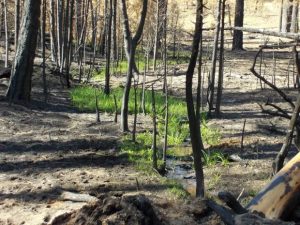Meeting On ‘Disaster Resilience’ Dollars
Sonora, CA — This Wednesday, two public meetings will focus on millions of dollars potentially at stake as part of a national competition in which Tuolumne County is the sole California applicant.
As a result of the Rim Fire, Tuolumne County was selected by the federal government to participate in the National Disaster Resiliency Competition (NDRC) Application. As Maureen Frank, deputy county administrator emphasizes, the NDRC application is not a grant but a competition that seeks to award monies, based on a number of variables; among them what other funding resources or “skin in the game” applicants plan to bring.
“It’s not a handout but a hand up,” Frank maintains, adding that Wednesday’s meetings are a prequel in anticipation of getting the green light from the federal government later this month that the county’s application is among those that will pass into phase two of the three phase process. As previously reported, back in March, the county and partnering state and federal agencies submitted the initial application to the Department of Housing and Urban Development (HUD) as part of phase one.
Two Meeting Times
The Wednesday meetings are scheduled from 1 to 3 p.m. and from 6 to 8 p.m. in the county board of supervisors chambers (2 South Green Street, 4th floor). The purpose, according to Frank, is to provide an update on what the NDRC group has done so far and to ask the community about what projects they want to see that would help the region respond to or recover faster from a disaster and ways to make the community more prepared and resilient.
Frank urges meeting attendance from at least two fronts, which include, she says, “If you think that your organization, your department has a project that might fit within the…competition guidelines, something that you’ve been working on that you might need some extra help to get it complete.” She also encourages input from “anyone who is interested in Tuolumne County…seeing what’s going on as we try to continually look at making it better, making our county more resilient from these kinds of disasters.”
While Frank states that the county and state have not yet heard any official word, they have received contact from the Rockefeller Foundation that is sponsoring and assisting the federal government on the grant. “So, that was a good sign,” she says, adding that another harbinger might be that several consultants, among them grant writers, have recently been in contact to offer their services.
Once applicants hear they will be invited to participate in phase two, the subsequent application, due some 120 days later in October, will need to provide deep project details. It is where, as Frank calls it, “the rubber meets the road.”
Anticipating Phase Two
Anticipated phase two application project details, according to Frank, would address those that are forest watershed and hydrology-related; infrastructure, such as water hydrant systems for high fire risk neighborhoods; public facilities and services that address unmet needs ranging from fully-equipped evacuation centers to career paths for youth adults, like forestry or fire science; and more resilient communications for first responders and the public.
Sometime in December applicants who are chosen to move on to phase three will be notified in time to award contracts, so that they can begin work on their projects by January 2016. According to Frank, among the requirements on grant recipients is that all approved projects must be completed within two years.
With the good fortune to be selected by the state as its sole application, Frank says, comes a responsibility to, if chosen as a final recipient in phase three, be an incubator and pilot for programs, processes and services that have only been in concept stage until this point. Theoretically, she asks, “If there was another emergency…another Rim Fire in another county…can what we’re [working on] be replicated in other communities, whether it’s in the state of California, or, for the most part, in the western US?”
Perhaps providing a partial answer to her question, Frank returns to the reason why she says the county was chosen by the state in the first place. “It’s all about best practices — how innovative we are in Tuolumne County — how collaborative…federal, state, local, and nonprofit…even though we don’t always agree, we work well together to solve or mitigate issues and concerns so the effects of an emergency aren’t as great in a community.”

